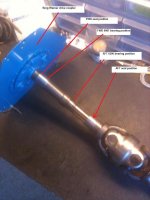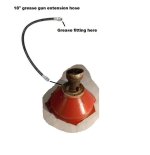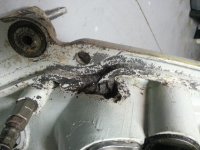I have my bell housing removed with the PDS sitting on my bench. This is off an AQ 225d with 280 DP drive. It is the red housing with the dual bearing PDS. I have removed three snap rings, one aft and two forward. The only one I still see in place is the small aft compression ring on the shaft. Should the whole PDS now come out aft? And does it typically require a lot of force? Not sure what to do next. I have tried tapping on the forward end of the shaft using a a wood block and hammer. I have seen the threads that talk about the single bearing PDS coming out aft but it is unclear to me on the double bearing PDS.
Thanks for any help you can offer.
Doug, my little V/P biz is pretty much with the AQ series exclusively. I've changed so many of these, I no longer recall how many.
I see the failures and what caused the failures, and I know what leads to longevity.
I've pulled these apart after an alleged V/P mechanic had previously installed new bearings, only to find that the mechanic did not pre-fill the grease cavity........ which means that the next XX pumps of grease never made it's way to the bearings.

I've found sealed bearings used where open bearings should have been used, and I've found open bearings used where sealed bearings should have been used. I've found mixed grease chemistry used that caused the grease to break down and turn into a liquidly substance.
I've seen damage anywhere from bearings only, to broken universal shafts, to extreme damage where it took out the flywheel cover snout, the PDS, the universal shaft and the transmission front bearing box clamping collar. Not pretty!
You can trust me on this...... you do not want to undergo a failure here!
You are wise to be replacing these!!!!!
 Here's what I'd suggest to you:
Here's what I'd suggest to you:
Yes... the two bearing PDS is easiest to remove from AFT.
Remove seals, remove the two large AFT snap rings.
With a rather large brass drift and good sized hammer, drive the PDS AFT..... it will come out.
If need be, apply heat the flywheel cover in this area.... the heat will expand it some, and most often will release the bearing so that it can slide out freely.
Once out and on the bench, then you remove the small C-clip that secures the 6206 bearing to the shaft.
Install the new "open" 6206 at this time.
Once the FWD snap ring is removed, the FWD PDS 6007 bearing can now be driven FWD from AFT.
Clean out the grease cavity.... purge the grease port.... and install the PDS in the reverse order.
DO NOT install seals yet.
You'll want to pre-fill the grease cavity first, until you see grease come through the ball cages.
Do this while spinning the PDS to purge any air.
Now and only now, are the seals installed.
NOTE: Excessive grease pressure can dislodge the FWD seal, so I've been either staking them, or gluing them into position.
If we loose the FWD seal, no future grease will make it's way through the AFT bearing....
the more important bearing!
NOTE:
The fwd seal installs in the conventional direction with the seal "lip" and tension spring facing towards the grease area.
IOW, this oposite side is facing towards the engine.
The aft seal installs in a non-conventional direction with the seal "lip" and tension spring facing towards the transmission area.
IOW, the same side also faces towards the engine making the lip and tension spring face the transmission side.
Reason: the lips hydraulically lock (to a degree) when pressure is against them, so between the two, we want the AFT seal to breach excessive grease pressure.....
not the FWD seal.
The AFT seal is NOT intended to be a water seal anyway. If we have water in this area, we have a bigger problem.
Parts:
Industry Standard 6206 and 6007 bearings in the open version in an electric motor grade...... about $14-16 each or so.
Japanese, German or US made................. NO BBQ'd Pork bearings.

The two seals are a 35X62X7mm in TCM or Timken. These are fully rubber encapsulated...... about $6-8 each.
If you need a snap ring, these too are industry standard.... NAPA will have them.
I suggest to people that these are lubed at around the 40 hour mark... or perhaps to not exceed an oil change interval.
Grease these with the engine running.... (dynamic -vs- static).
With the grease cavity properly "Pre-Filled" and purged of air....., three/four pumps should do it. 
The shaft comes out thru the engine side. It does need a little help out with the deadblow hammer.
The PDS can be removed from the front area, however, in order to do this, the small contraction type C-clip ring must be removed since the 6206 cannot go forward within the flywheel cover......... and it's a real bitch to get to the small C-clip from AFT while still installed.
You can do as Boatdoc says, but IMO, it's best to remove the PDS from the front towards the rear. As it comes out, so will the 6206 bearing come out along with it.
Once on the bench, now the 6206 can be removed and replaced.
Here's two images.
First one shows the position where the bearings/seals are on the PDS and female yoke.
Second one shows what I've been doing to every F/C that leaves my shop. This hose gets fastened somewhere on the engine where it will be visible and easy to get to for greasing.
The OEM grease zirk location sucks.... people forget that it's there! 



